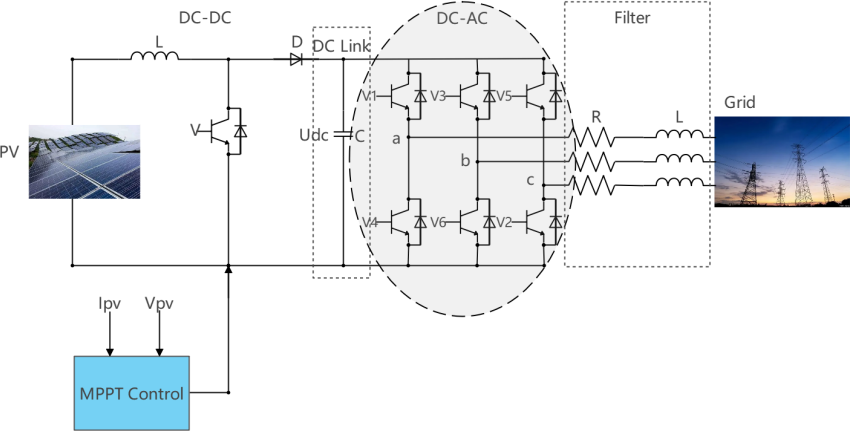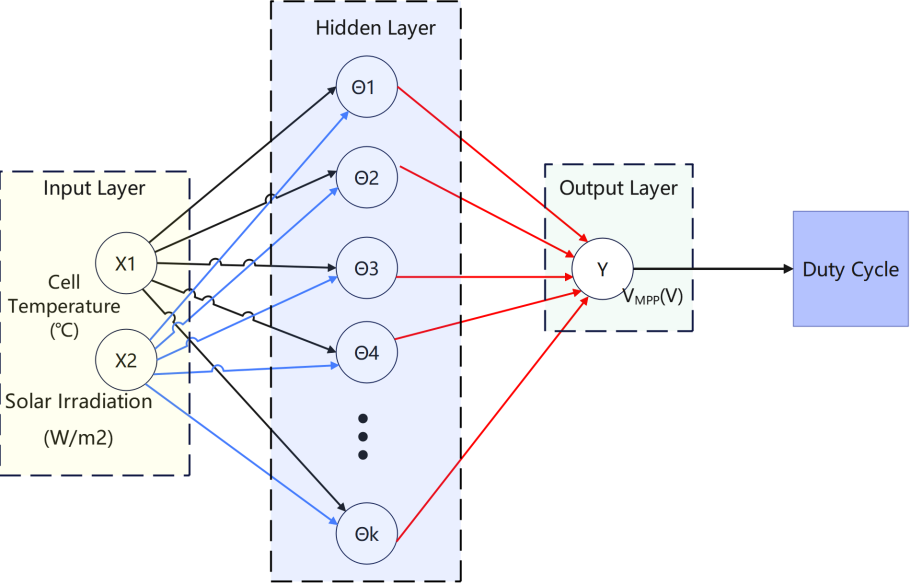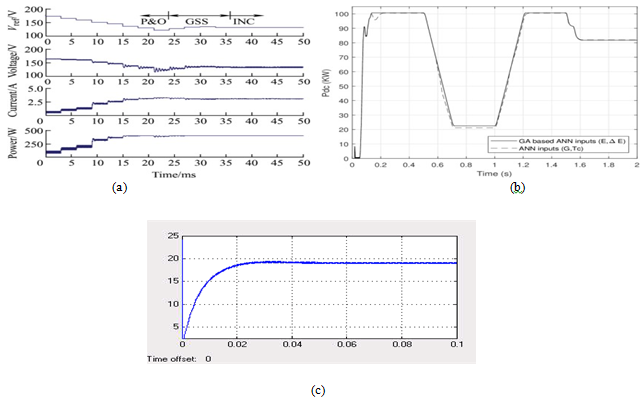Ijraset Journal For Research in Applied Science and Engineering Technology
- Home / Ijraset
- On This Page
- Abstract
- Introduction
- Conclusion
- References
- Copyright
An Analysis of the most Promising Strategies for Controlling the MPPT of Photovoltaic Systems
Authors: Dr. A. Gowthaman
DOI Link: https://doi.org/10.22214/ijraset.2024.64065
Certificate: View Certificate
Abstract
There has been a tremendous increase in the utilization of renewable energy sources, particularly, solar energy. In terms of potential energy sources, photovoltaics are among the most promising. This article provides a concise assessment of the prospective approaches of maximum power point tracking (MPPT) control for the photovoltaic system. To begin, a discussion is held regarding the fundamentals of the photovoltaic system, including the concept and fundamental theory behind the P&O MPPT control method, which is frequently utilized. After that, three of the most promising techniques for enhanced MPPT control are selected. There is also coverage of research that is meaningful on the fundamental theory and the primary concept of the three techniques. Several of the research findings from different approaches are compiled in this document for the purpose of comparison. The tracking time, the complexity of implementation, and the accuracy are the three main indexes that are examined in this final comparison of these three systems. The efficiency, accuracy, and applicability of these methodologies are indicated by these indexes, which can serve as a meaningful reference for future applications and additional research.
Introduction
I. INTRODUCTION
The data from British Petroleum indicates that the proportion of energy that comes from solar and wind sources has increased by 226 gigawatts in the year 2021. Since 2018, the proportion of renewable energy sources (excluding hydro) that contribute to the generation of power on a global scale has been steadily growing. In 2021, renewable energy will account for about 13% of the world's total power generation. This is due to the fact that the solar and wind energy sectors have experienced tremendous expansion. By the year 2020, renewable energy sources, such as solar, wind, and hydropower, accounted for 83 percent of the newly installed capacity for generating electricity. Based on the statistics, it is anticipated that in the future, a clean and sustainable energy system will be implemented, and renewable energy will account for a greater proportion of the total power in the world. In this process, photovoltaic (PV) is the most important alternative renewable energy source until the year 2040, according to a number of governments and businesses. The light intensity is variable and the power is not fixed when it comes to the implementation of the photovoltaic grid-connected inverter system. This is because of the diverse weather conditions. Temperature and irradiance are two factors that have a significant impact on the amount of energy that may be generated by a photovoltaic system. Nevertheless, these elements are so unpredictable and difficult to handle manually that a control approach known as Maximum Power Point Tracking (MPPT) is frequently employed in photovoltaic (PV) systems. The purpose of this control method is to modify the operating point of the PV system in a timely manner in order to ensure that the system is always running at or very close to its maximum power point. There are a few strategies that have been utilized extensively in prior research. These techniques include the Perturbe and Observer (P&O) methodology, the Incremental Conductance (INC) technique, Fuzzy Logic Commands, and other techniques. As an illustration, the implementation of the Perturbe and Observer (P&O) algorithm involves monitoring and modifying the output voltage of the solar generator in order to shift the operating point closer to the maximum power point. On the other hand, it has been demonstrated that P&O will result in a loss of power as a consequence of the perturbation. It is possible for INC to provide responses that are not accurate due to the fact that binary floating-point numbers are unable to accurately represent real values. This makes it impossible to locate the zero-value point on the slope of the P–V characteristic, which is the hypothesis. Fuzzy Logic Commands are capable of properly tracking MPP and obtaining a consistent MPPT algorithm; nevertheless, they require a big memory and a huge scale of training, and they have limited adaptation to varied situations. Recently, a number of better approaches for controlling MPPT have been published, and these methods have the potential to improve the performance of PV systems. The comparison of numerous prospective MPPT control approaches will be the primary emphasis of this research for comparison. In the future, the purpose of this study is to propose ideas for additional research and industrial application, as well as to review the respective approaches that have been discussed. The primary approach of research is to extract information from earlier studies and then collect data for the purpose of comparison.
The fundamental idea of maximum power point tracking (MPPT) is presented at the beginning of this paper. Subsequently, the research concentrates on three promising improved MPPT methods, namely the Golden Section Search-based MPPT Algorithm, the Artificial Fish Swarm MTTP Algorithm, and a comparison of these methods. With regard to the fundamental idea and performance index of All of these MPPT control mechanisms are going to be discussed. Following that ,a conclusion is presented.
II. PV SYSTEM MODELING
A. PV System
Figure 1 illustrates the primary configuration of the two-stage three-phase photovoltaic grid-connected inverter. The system comprises a photovoltaic array, a boost converter, a DC-AC converter, and an RL filter. An MPPT control model is utilized to promptly modify the operating point based on the observed data Ipv and Vpv. The effectiveness of the two-stage topology structure in achieving separate adjustment of grid-connected control and maximum power tracking control has been demonstrated .

Figure 1. The grid-connected PV plant
B. Conventional MPPT Algorithm
The P&O method is currently a well-established algorithm. Its fundamental operating principle involves applying various directions and quantities of disturbance to the output voltage or current of the PV cell. Subsequently, the disparity in output power following the disturbance is measured in two consecutive intervals. The direction of disturbance in the next period is determined by comparing the difference with the direction of disturbance in the current period. Through continuous disturbance and observation, the system will progressively converge towards the maximum power point (MPP). However, PV cells of various types exhibit distinct output characteristics, necessitating the adoption of varied disturbance step sizes in the P&O management algorithm based on the specific type of photovoltaic cell and the prevailing external conditions. Reducing the step size of the MPPT algorithm results in a decrease in tracking speed. However, when the step size is near the MPPT point, there is minimal power fluctuation, leading to improved energy use efficiency. When the step size is increased, the tracking speed of the MPPT algorithm is accelerated. However, when it approaches the MPPT, there is a significant increase in power fluctuation, resulting in substantial power loss. Hence, it is challenging to take into account both the dynamic and steady performance of the fixed-step algorithm. The predominant solution is referred to as the variable step size of the MPPT algorithm. Reference provides a more enhanced algorithm.
III. ENHANCED MAXIMUM POWER POINT TRACKING (MPPT) ALGORITHM
Several enhanced Maximum Power Point Tracking (MPPT) algorithms have been published, building upon the traditional P&O, INC, and other artificial methods.
A. Golden Section Search-based MPPT Algorithm
Reference proposed the utilization of the golden section search (GSS) approach in conjunction with the P&O and INC techniques to develop a multi-stage MPPT algorithm. One can integrate this method with P&O and INC to construct a multi-stage MPPT algorithm. During the initial stage, it is advisable to select a perturbation step of considerable magnitude in order to swiftly identify the maximum power point (MPP) within a limited range, in accordance with the P&O characteristic. Next, the second stage employs GSS to further refine the range. Once the interval width meets the Golden Section Search (GSS) criteria, the third stage employs the Incremental Search (INC) method to validate the Maximum Power Point (MPP). When the Maximum Power Point (MPP) changes, the system will initiate the entire procedure anew, starting from the initial stage to locate the MPP once more

Figure 2. A schematic representation of a photovoltaic (PV) system that incorporates a GSS-Based MPPT.
The diagram of the single-phase grid-connected PV system equipped with a GSS-based MPPT algorithm is depicted in Figure 2. The voltage controller of the boost chopper and the voltage controller of the inverter both employ PI compensators. The MPPT algorithm is responsible for the Vref of the voltage controller of the boost chopper. Nevertheless, the Vref of the inverter's voltage controller is determined by the amplitude of the grid voltage.
B. Artificial Fish Swarm MTTP Algorithm (AFSA)
The Artificial Fish Swarm MTTP Algorithm is derived from established swarm intelligence algorithms in order to achieve global optimization. The algorithm presented in this study is derived from the natural behavior of fish and incorporates four fundamental concepts through abstraction.
The initial phenomenon is referred to as AF-Random behavior, wherein individual artificial fish frequently engage in random swimming patterns within the aquatic environment, with the objective of locating a broader range of food sources or near by companions.
The aforementioned principle can be mathematically represented by the following formula:
Xi / next = Xi + r ´ Sight
1)
Where r is the random number with domain [-1,1], Sight is the maximum distance the artificial fish can detect. X is an n-dimensional vector which expresses the position of artificial fish, so
X ? (x1, x2 , x3 ,..., xn ) .
The second phenomenon is referred to as AF-Swarm behavior, encompassing three distinct rules. The separation rule posits that artificial fish exhibit a tendency to actively avoid overcrowding with their adjacent counterparts. The alignment principle states that individuals will strive to maintain consistency with the average direction of their adjacent partners. The cohesiveness rule dictates that individuals would strive to cluster themselves as closely as feasible to the center.
This principle can be expressed as the following mathematical formula:
Xi mean the position of the artificial fish and Xi / next means the next position
Where Step is the length that the artificial fish move at one time, Xc is the position of the center and Xc ? X I is the distance between the individual artificial fish and center.
The third is called AF-Prey behaviour, which means when artificial fish find food, they will swim quickly in the direction of increasing food. Suppose an Xj is randomly selected, the artificial fish will calculate the food density Yj. If Yj>Yi, it will move in the Xj direction. This process can be expressed as the following mathematical formula:
The fourth behavioral pattern is referred to as AF-Follow behavior, wherein the presence of food prompts the nearby partner of one or more artificial fish to promptly pursue the food source. The mathematical equation is identical to formula 3. In this particular scenario, Xj represents the spatial location of an additional fake fish, where Yj exhibits the greatest magnitude within the domain of detection.
C. An Improved ANN based MPPT Method
Artificial neural networks (ANNs) have found extensive application across diverse domains. This technological advancement enables the rapid retrieval of precise solutions from intricate mathematical models. Numerous researchers have employed artificial neural networks (ANNs) in maximum power point tracking (MPPT) systems to enhance the efficiency and accuracy of MPP tracking across diverse situations. According to Reference , Artificial Neural Networks (ANN) have demonstrated superior performance compared to P&O and ANFIS. However, several researchers put proposed improved ANN based MPPT algorithms to attain a better performance.

Figure 3. The basic ANN architecture for MPPT.
To accomplish maximum power point tracking (MPPT), conventional ANN-based methods typically use cell temperature and solar irradiance as input parameters to the DC-DC boost converter, which then adjusts the PV voltage.
Two other parameters, error signal (E) and error signal change (DE), are presented by M.Nour Ali [14]. His value can be determinedusingformula5.
E = dPdc (5)
dVpv
This device detects minor changes in E and responds to the trend of Delta E, making it more sensitive than inputs such as cell temperature and sun irradiation. When E equals 0, the MPP is found.GA optimization is also used to increase the performance of artificial neural networks.
IV. EVALUATION OF THE ENHANCED MAXIMUM POWER POINT TRACKING (MPPT)
This section compares the three updated MPPT algorithms in four key areas: structure, tracking time, implementation complexity, and accuracy.
A. The Comparison of the Structure
The three approaches differ in their structure.
The Golden Section Search-based MPPT is made up of three primary elements. This approach combines P&O with INC to create a multi-stage algorithm. The stages are in the following order: P&O, GSS, and INC. The Artificial Fish Swarm MTTP technique is a one-stage technique that use AFS to determine the MPP. AFSA is not a sophisticated algorithm, but it is very efficient and accurate. The enhanced ANN-based MPPT approach employs an improved ANN that uses different input than traditional ANN and is equipped with GA optimization to search the MPP, which is also a one stage algorithm. However, the structure of an ANN might vary depending on the application. In comparison, the golden section search-based MPPT is a multi-stage algorithm, whilst the others are single-stage ones.
B. The Comparison of the Tracking time, the and complxity of Implementation the Accuracy

Figure 4. The output waveform of three improved methods. (a)GSS, (b)AFSA, (c) Improved ANN
It can be found that the three methods all achieve a stable output in a short time. In table 2, more details are provided.
Table 1. Major Characteristics of MPPT Algorithms
|
Method name |
Tracking Time |
Implementation |
Accuracy |
|
P&O |
Medium (28 500 ms)[12] |
Simple |
98.28 %[12] |
|
GSS |
Very short (36 ms)[12] |
Complex |
Very high (99.94%)[12] |
|
AFSA |
Short (1023 ms)[6] |
Simple |
Higher than P&O[6] |
|
Improved ANN |
|
Medium |
Higher than manual designed ANN[14] |
Table 1 demonstrates that, in terms of tracking time, the Golden Section Search-based MPPT approach takes the shortest time, followed by AFSA. The research does not include tracking time for enhanced ANN, however it is shorter than P&O. Although AFSA has a far shorter tracking time than P&O, it still takes 25 times longer than GSS. The complexity of implementation is strongly connected to the structure of the methods. As a result, P&O and AFSA are considered simple to implement. GSS's multi-stage design makes it difficult to deploy.
The enhanced ANN is more sophisticated than AFSA but easier than GSS. The accuracy of GSS has been tested to be quite high (99.94%), however the actual amount of accuracies for AFSA and enhanced ANN is not stated. However, when compared to other approaches, the results show that AFSA is more accurate than P&O, and enhanced ANN is more accurate than manually constructed ANN. All of these strategies enhance tracking speed and accuracy, particularly GSS. GSS makes use of both P&O and INC to overcome the limitations of these traditional approaches.
AFSA proposed the use of universally applicable artificial methods for MPPT control, which was shown to perform better than the conventional P&O method. The upgraded ANN delves deeper into the Artificial Neural Network domain and makes improvements that align with the industry's future trends. However, some limitations remain. Aside from the difficulties of implementation, GSS is currently only applicable to MPPT of unimodal functions. Under partial shading, this algorithm must consider additional locations to locate the MPP [12]. The Artificial Fish Swarm algorithm is highly efficient in terms of fish scale and maximum number of iterations. As a result, when applied to systems with enormous scales or complicated environments, a high-performance processor is required. The upgraded ANN still confronts the basic difficulties of AI systems, such as long training times and poor adaptability to varied contexts.
Conclusion
This study presents an overview of PV systems and typical conventional MPPT control approaches. This paper selects three interesting MTTP control approaches for comparison. The core principle and performance indices are summarized. The major advantages and cons of various strategies are discussed. According to the research, the GSS-based MPPT algorithm performs the best. However, this approach combines GSS, P&O, and INC to create a multi-stage MPPT algorithm that is complex. The main disadvantage of GSS is that it cannot be used for multimodal functions. The Artificial Fish Swarm algorithm and enhanced ANN have fewer complex structures and outperform conventional MPPT control methods. These are promising techniques, especially given the rapid progress of AI. The fundamental issue for AI systems is to improve adaptability while shortening the training cycle. This article claims that using AI technology can result in a more efficient and less complex MPPT algorithm. The complexity can be minimized by utilizing artificial neural networks. Future research can focus on shortening AI training cycles to make the MPPT control mechanism more efficient and adaptive. Furthermore, the parameters used to detect the PV system may be improved, resulting in increased accuracy and promptness. These prospective improved MPPT control approaches are worth more investigation in the future.
References
[1] Dr.A.Gowthaman , Dr.Mohammadha Hussaini , Dr.P.Govindasamy “Cooling techniques for cutting-edge photovoltaic modules” International Journal of Innovative Research in Electrical, Electronics, Instrumentation and Control Engineering Impact Factor 8.021 Peer-reviewed & Refereed journal Vol. 12, Issue 7, July 2024 DOI: 10.17148/IJIREEICE.2024.12706 [2] Dr.M. Mohammadha Hussaini, Dr.A. Gowthaman, Dr.P. Govindasamy, \"Solar-powered debris collector designed for water bodies\", IJARCCE International Journal of Advanced Research in Computer and Communication Engineering, vol. 13, no. 3, 2024, Crossref https://doi.org/10.17148/IJARCCE.2024.13311. [3] Dr.A.Gowthaman, Dr.P.Govindasamy “PV Supported Power Quality Improvement in Grid using Static Synchronous Series Compensator (SSSC)” International Journal of Advances in Engineering and Management (IJAEM) Volume 5, Issue 7 July 2023, pp: 839-848 www.ijaem.net ISSN: 2395-5252 [4] Gowthaman, A., and Anita, R. (February 13, 2019). \"Renewable Energy–Supported Hybrid Active Power Filter for Grid-Connected Application.\" ASTM International. J. Test. Eval.. February 2019; 47(2): 1332–1359. https://doi.org/10.1520/JTE20170494 [5] Haegel, N. M., Kurtz, S. R. (2021) Global Progress Toward Renewable Electricity: Tracking the Role of Solar. In IEEE Journal of Photovoltaics, vol. 11, no. 6, pp. 1335 - 1342, doi: 10.1109/JPHOTOV.2021.3104149. [6] Cheikhne, A. C., Mohamed.C., Mohcine, M. (2019) MPPT Control for Photovoltaic System using hybrid method under variant weather condition. In 2019 International Conference on Wireless Technologies, Embedded and Intelligent Systems (WITS), pp. 1 - 5. [7] Motahhir, S., El Hammoumi, A., El Ghzizal, A. (2018) Photovoltaic system with quantitative. comparative between an improved MPPT and existing INC and P&O methods under fast varying of solar irradiation. Energy Reports, vol. 4, pp. 341-350, 2018 - 01 - 01. [8] Chen, Y.M. (2021) Research on Maximum Power Point Tracking Method of photovoltaic grid- connected power generation system, [D]. Shandong university. DOI: 10.27272/d.cnki.gshdu.2021.006726.
Copyright
Copyright © 2024 Dr. A. Gowthaman. This is an open access article distributed under the Creative Commons Attribution License, which permits unrestricted use, distribution, and reproduction in any medium, provided the original work is properly cited.

Download Paper
Paper Id : IJRASET64065
Publish Date : 2024-08-24
ISSN : 2321-9653
Publisher Name : IJRASET
DOI Link : Click Here
 Submit Paper Online
Submit Paper Online

